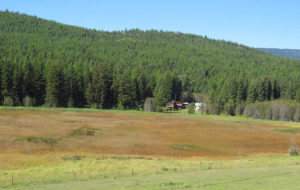Wetland Protection in Upper Wauconda

In November 2013, OHA approved an application for reimbursement for Wauconda landowner, Lee Johnson. Lee sought reimbursement for expenses for fences to protect a unique and exceptional wetland that he recently purchased.
Having lived adjacent to the wetland for over 30 years, Lee has built and maintained a fence that protects this resource, long before he actually purchased the wetland.
The protected area includes approximately 25 acres of wetland and forest fringe, laying north of Bunch Road at 4,000 feet elevation.

The wetland supports waterfowl, shorebirds, marsh dependent birds, amphibians, and mammals including moose, elk, deer, muskrat, weasels and skunks, flying squirrels, and bats. There are rich communities of mosses, lichens and unique wetland plants.
The tall forest fringe on the south/southwest side protects the wetland from the hot summer sun, keeping the wetland waters cool and well oxygenated. The colder the water, the more oxygen can be dissolved in the water. The cool water supports insect and amphibian life, creating a strong foundation for the pyramid of life in the wetland.

Jeff Heinlen, Wildlife Biologist for the WA Department of Fish and Wildlife, is interested in this wetland. “We are fortunate in the Okanogan to have Black Terns nesting here, as this is the western edge of their range,” Heinlen says. He goes on to explain that these beautiful, graceful birds nest in mud humps or riparian vegetation surrounded by open water, usually in colonies. “Recent nesting documented on Lost Lake and on Little Beaver Lake in the Okanogan Highlands has only been individual nests, not colonies. Talking with Lee about his wetland and the number of Black Terns there during the nesting season, it sounds like this pond holds the largest amount of nests in the County. A big thanks to Lee for taking such interest and care in this pond so we all can enjoy these wonderful birds.”
OHA funds supported Lee’s reconstruction of old failing fences to maintain cattle exclusion. Lee’s long-term plan for the wetland includes enhancing future beaver habitat by planting appropriate trees to function as food for beaver. This would encourage beaver to rebuild and maintain the dams that have been degraded by cattle presence in the past, which has affected the water levels over time. He also hopes to find help to reinforce and heighten the degraded water impoundment structures. In approximately 1999, he placed 300 sandbags to shore up the degraded beaver dams and would like to do more work of a similar nature.

“I started building my log home on this spot 40 years ago, this spot because of its view of the wetland and the waterfowl, amphibians, birds and mammals associated with the water source. As the years passed, I became more aware of how special and how dynamic a wetland can be as a central gathering place for most of the wildlife populating an area, to rest, nest, drink and raise young. Dry periods drew cattle to seek the remaining water, trampling the dams and causing lasting problems with the water levels. Building fences to exclude cattle and doing what I could to reinforce the dams has ensured many more years of productivity to this important wetland.
“I’m grateful for the support of the Highlands Alliance in helping with the maintenance of the fences that protect this unique wetland. Being able to purchase high quality fencing materials, like pressure treated wood and steel posts and new wire, means a lasting fence needing less ongoing monitoring and maintenance, allowing more time and energy to work on other conservation efforts on my property. It is also encouraging and gratifying to have the value of this spot so dear to me recognized and supported by a great conservation organization like the Okanogan Highlands Alliance. Thank you David Kliegman, Julie Vanderwal, and the OHA board for extending this most welcome support.”
Lee Johnson
OHA appreciates Lee’s commitment to protecting and restoring this wetland. We demonstrated our support by covering the cost of materials for the fence improvements.